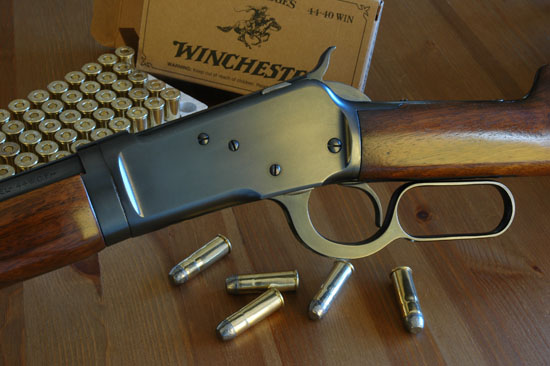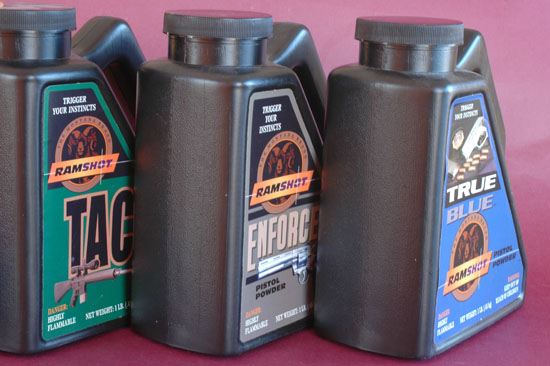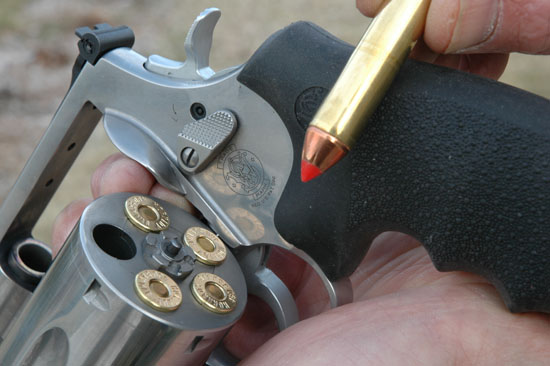

When it comes to reloading ammunition, Wayne van Zwoll says handloading cartridges requires special attention.
Firearms come apart when gas pressures from burning powder can’t leave soon enough. Time matters. Pressures can’t build to dangerous levels if you don’t give them time.
On the other hand, you must give pressures time to build to useful levels. The bullet is an obstruction. Its resistance (friction and mass), plus barrel length and the relationship of bore to case capacity determine the appropriate powder and charge. A charge of fast-burning Bullseye powder behind a lightweight bullet in a .45 ACP pistol generates a sharp, quick thrust. It must, because that short bullet is easily dislodged.

As it races through the short bore, a huge space opens instantly behind it. The powder has little time to work before its energy dissipates. Think of a ping-pong paddle in action.
A rifle powder such as 4350 in a bottleneck case like a .270 generates pressure more slowly as it burns. The bore is small, relative to case capacity, and the bullet long. An instant burst of energy from Bullseye wouldn’t give the sustained push needed to overcome bore friction and accelerate the long, slim .270 bullet through a long barrel.
Heavier charges of fast powder would lift pressures to dangerous levels. Bore space behind the bullet wouldn’t increase fast enough to relieve it. Think of that ping pong paddle meeting a baseball. The paddle (or your wrist) would yield before the momentum of the incoming ball could be reversed.
Like handgun ammunition, shotshells use faster powders than those in bottleneck rifle hulls. The heavier the shot load, the slower the powder. Short pressure curves don’t mate well with slow acceleration against high resistance. Also, shotgun barrels and/or actions weren’t designed to bottle stiff pressures. Big bores and straight cases flush pressure out fast.
Rifles of modern steel seldom come apart. Acceptable breech pressures of smokeless centerfire rounds as determined by SAAMI (Sporting Arms and Ammunition Manufacturers Institute) run from around 42,000 psi for the .30-30 to over 60,000 psi for high-velocity magnums.

Several bolt rifles safely digest proof or “blue pill” loads of more than 100,000 psi. Famously, Springfield 1903 receivers to serial number 800,000 (in 1917) were of case-hardened, low-carbon steel, not as strong as subsequent double-heat-treated receivers. These acceded to even stronger nickel-steel receivers at serial number 1,275,767 (in 1927).
Proper charges of proper powders help keep your rifle intact. But careless mixing of cartridges can make even safe loads hazardous. Once a pal inadvertently loaded a .308 round in his .270. The .308 cartridge is shorter, so the bolt closed before the bullet met the smaller neck of the .270 chamber.
When he fired, pressures vaulted as the .308 bullet squirted through the .277 bore. The bolt froze shut. Gas from the ruptured case blew the extractor off and jetted through the magazine well, splitting the stock into three pieces. Fortunately, the Mauser lugs did not fail, and my friend was wearing glasses.
Another way to blow a rifle is to not use any powder at all. Once, having heard only the hammer fall as I triggered a borrowed rifle, I opened the action and ejected a fired case. “Must have forgotten to cycle the lever,” thought I, and chambered another round. But just before I fired, another possibility came to mind. Action open, I looked into the bore. Dark.
The rifle’s owner had failed to add powder to that first case. The primer had driven the bullet inches into the bore. Had I launched another 200-grain softpoint, pressure would have spiked as it collided with the stuck bullet. The Model 71 Winchester would almost certainly have been ruined, with injuries likely.

Don’t use someone else’s handloads! Pull the bullets; use the components.
You’ve read caveats about firing smokeless loads in Damascus shotgun barrels – those made by wrapping heated bars around a bore mandrel. The rule makes sense, as does the use of black-powder or “smokeless for black” (not full-power smokeless) loads in old double rifles. In truth, some early rifles and Damascus shotguns thrive on modern ammo.
I have it on good report that the actions and barrel thickness of Parker shotguns dating to the early 20th century are such that Parker proofed to higher pressures than generated by modern target loads, even some duck loads!
Still, barrel steels of a century ago don’t match ours today. Breeching that has become loose, or weak cases or oversize or damaged chambers add risk. When in doubt, have the gun examined by people with appropriate equipment and expertise, or stick to mild loads.
Hewing to conservative loads in old guns, and taking care to use the right powders and ammo can keep stock and steel in one functional piece, and you, too.

Next Step: Get your FREE Printable Target Pack
Enhance your shooting precision with our 62 MOA Targets, perfect for rifles and handguns. Crafted in collaboration with Storm Tactical for accuracy and versatility.
Subscribe to the Gun Digest email newsletter and get your downloadable target pack sent straight to your inbox. Stay updated with the latest firearms info in the industry.








QUOTE; A rifle powder such as 4350 in a bottleneck case like a .270 generates pressure more slowly as it burns. The bore is small, relative to case capacity, and the bullet long. An instant burst of energy from Bullseye wouldn’t give the sustained push needed to overcome bore friction and accelerate the long, slim .270 bullet through a long barrel. QUOTE;
Not exactly true. Although it is true a large charge of Bullseye in a rifle will blow it up, it is not true that you cannot use a low charge to propel the bullet out of the case and down the barrel. Cast bullet shooters have been doing it for years in complete safety. I have in the past used a light charge to clear out a stuck bullet in a barrel rather than beat it out with a rod and risk damage to the bore. Of course you can do the same with a charge of much slower burning powder as well if you are at the range but if you are at home and have the proper back stop you can literally bounce the bullet off of a wood back stop at very low velocity to clear out a stuck bullet with a grain or two of bullseye.
As a professional Gunsmith and long time NRA competitive shooter Wayne is on the mark. In New Zealand I get lots of opportunity to examine blown up rifles and review firearms accidents. The 308 in a 270 is a very common accident, others include leaving the cleaning rod in the barrel of a large magnum, special chambers as tight throat in chambers, tight bore and groove barrels, old cases, bad gunsmithing, wet ammo and chambers, powder variations from lot to lot, bad safety design in actions, poorly maintained rifles, bad training by so called experts, worst is disregard for the safety of not only yourself but others. Best advice is expect a problem and work a defense in preventing it, constantly seek good information so that you don’t repeat someone else’s accident, hiding accidents only invites others to do the same . M R Maxberry
Many people (including gun writers) are often unaware that the 1917 U.S. Enfield rifles also blew up from a bad lot of steel received at the Eddystone arsenal (the lowest quality arsenal of the 3 arsenal’s that made these guns. Mr. Ferris in his book “The 1917 Enfield” documents this.
In Ohio one of the ordnance officers recommended that no U.S. 1917 Enfields be sold to the public. Mr. Ferris had 11 Enfields sitting in his rack and while writing the book noticed that all 11 rifles were of different overall lengths. Parts interchangeability was bad as the gun was largely produced with no blueprints, only drawings.
What is really useful is being able to create ammo that is not made anymore. This is not for the beginner. A good example is the 8mm Siamese Mauser. No surplus military ammo was ever imported for this gun thank God and this prevented the cheap skates from destroying all these beautiful guns with mint bores with unsafe and inaccurate corrosive military surplus ammo. Hurray, as we now have most of these guns with mint bores.
Wayne:
“Famously, Springfield 1903 receivers to serial number 800,000 (in 1917) were of case-hardened, low-carbon steel, not as strong as subsequent double-heat-treated receivers. These acceded to even stronger nickel-steel receivers at serial number 1,275,767 (in 1927).”
You have managed to perpetuate a common error. The double heat treated Springfield 03 receivers (and the Rock Island double heat treated receivers) were actually somewhat stronger than the later nickel steel receivers.
The nickel steel receivers were easier to make and that is the reason they were adopted. Not case hardened, they are all “stickier” than the earlier double heat treated. The later Remington made 03s have a hardened surface similar to the high-number Springfields. The 03-A3s were probably also surface hardened, although I’m not certain of this.